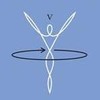Description
About This Video
Transcript
Read Full Transcript
Good morning. Amy, how are you? How are you? I'm fine. Um, so we've worked together before and sometimes when I come you say, pat, could you please help me with my shoulders? I do. And how are your shoulders right now? Um, can I do this to assess it? I, you know, the usual feels a little sticky little just not as mobile as I'd want them to be. Okay. So I have a few exercises that, um, I'd like to give credit to. One of my friends, his name is Dale Greenwald and he's an exercise physiologist. He and I used to present at medical courses and he has a couple of exercises that come from what he calls his daily dozen.
And he says if we would do these exercises every day, we could relieve a lot of neck tension. We could increase the strength in our back. In other words, we could apply it to our activities, which in this case is PyLadies. Okay. Okay. So let's just stand here for a moment and I want you to just tap on your sternum. Okay? So we all know where our sternum is. And then if we turn around, we know where the Scapula are.
How many Scapula do you have? That's very good. All right, so the scapular here and in Amy's case, the point at the bottom, you can think of it simplistically as a triangle, although part of it comes around to the front and then the shoulder joint is actually down here. So the Scapula and the sternum are part of what we call the shoulder girdle. And that includes our clavicle. So you knew all that? Yes. You did. All right. So many times our shoulder blades were told to pull the shoulders down.
Yeah. And I'm glad you did that. Um, because Amy's a teacher and I'm a teacher and one of the things that I found when I had my friend Dale assessed me is I was going at it like this. So when you said down, you went down and you do that probably to demonstrate to your students? Probably so. Yeah. And I was told once by a teacher of mine, boy, if you want them to lift their leg and you want to make a correction, what you do is you do it 10 times bigger and harder than what you really want to get them to do anything. So this is something that I think anybody who's doing exercise might be well to think about is to do these exercises with flow and rhythm. Does that sound like some PyLadies principles that, yeah. Okay.
So I thought that was interesting coming from a weight trainer. All right, so the first thing that we're going to do is talk about the relationship of the Scapula to the Scapula to the sternum. And so I bought a stick along. It says nothing like a visual and I'm going to put it straight out here. Coming out from your sternum. Could you let your sternum go down a little bit? Okay. And the stick is going down.
Does the space between your shoulders get narrower? This space gets wider from here in the front. No narrower. It gets narrower. Is that something you'd like to have? No. Okay. So our goal here is to get more space, maybe elongate these muscles. Okay. And then in the back, if we put a our stick right here, go ahead and let that sternum go down again.
And so what happens to the Scapula? Widen away from it. They widen away. And do they go up or down? Yeah, they went up. So they kind of surf over top of the shoulder. So this is a little important thing to remember and perhaps our hip joint would be the best way to demonstrate this. I'd like you to just stand and lift your leg up and you can face sideways and you lift your leg up. And this is your femur. Okay?
It's a different kind of femur. Okay. So as you lifted up the knee end of the femur goes up or down and goes up. Okay. So the knee n goes up. What does the hip joint have to do relative to the knee and going up? It goes down. So if you do that again, we could see knee up hip joint down.
Let's go back to sternum and Scapula. Chest up, scapula down, sternum, down. Scapula. Up, chest up, Scapula, down, scapula, down chest, gets wider, sternum down, chest gets narrow, puts a lot of tension in the neck, and you don't feel good that way. That's good. That's one of the things you're looking for in yourself and in your students. Does what you're teaching. Make them feel better. Okay, so now we have that.
We're going to start with a little exercise and you're going to put your hands out like this. So you're holding something and this is called super nation. And when you come out and your hands are pressing down, so we were walking on all fours, that would be pronation. And so then we're gonna come in and we're going to go out and in and out. Good. And in and out.
Now I'm going to turn Amy around and I'm reminded of something that Kathy grant set taught, talked about, which was the piano muscle. Think of it coming down the arm all the way down through the shoulder joint into the scapula. So good weight training also includes this concept. So why don't you push your fingertips toward the ocean. Just push them forward and feel these spread apart and then I want you to just bring your fingertips back to your body from here and then push forward and then from here, good and out and coming in super loose using lower traps, some of the mid traps and probably some of the Rhomboids to feel this now as she'd go out. I'm going to move your ponytail over for a minute.
Can you pull in from up there? Just just pulled together up there. All right, you see there's a little more tension in the neck, so we're going to move that down to here. There you go. And out and sliding and alto, the scapular actually sliding around your rib cage, so let's turn front again and put your arms down. You can rest for a minute and we're going to talk about pronation and supination when we're teaching. It's interesting. We go along in life, little events happen sometimes. This chain, the piano muscle chain includes the wrist clues, all the hand, the elbows, the shoulder joint. Now we know the Scapula and there are instances where people can't move one or more of the joints. Therefore all of the joints are not moving.
So let's just move our hand. Okay, so we're moving our hand, moving her hand, moving your hand, moving in her hand, moving her hand. So that would be your wrist. If we were to look at our elbow, you can see that this bone and I happens to speak called the radius, does have a radial surface. Like a little, yeah. So you would imagine that when it moves it goes around, right? So we are shaped for function.
So as the hand goes from supination and pronation, do you see how the radius appears to roll over the Elma? Okay. Yes. So it has to do that. A lot of people lose that ability. So I want you to put your hand here or let me just have this one. Okay. And then you're going to, is that pro nation or super nation? That's nation.
Yeah. Over. So even if I don't know what it is, there we go. Coordination. Now can you do that just in your lower arm?
Pronated and supinate it good. And protonated and supinated. So what we'd like to see is as you go out the Scapula, moving shoulder, joint, moving elbow, moving risks, moving then the scapula and coming in. Good. Now remember the bone goes up, the bone goes down, one end up, one end down. If you were to imagine this, okay, here, pull your elbow behind your midline. Okay, so this is the angle. So do you see how that's going forward? I do see how easy it might be to get really enthusiastic about this exercise.
Pull back and imagine that if I pull back, that's gonna make your chest open. So if I bring you here and I say, can you broaden here? Broaden there. Good. Now out. And as you come in, you're going to broaden and you're going to stop right at your sideline. Okay? So I think what's happening to you sometimes is maybe in an exuberance to teach you pull back. So they see this open. Hey, now I opened this. You see the difference? The difference. Okay. Because I can't see myself right now. Okay. I can feel what you're doing. Okay, so we turned sideways. Maybe the audience can see.
So go ahead and reach out. These are called reach and polls. Good that you went behind your line. Yeah. If anybody's looking, you'll see that when this little bump do you want to call it? The bump on the top went forward. So she's going to go out and right here using rhythms. Sliding. She's going to write about here. Think arm back and widen your chest, widen your chest, widen your chest. That's it.
So can do you feel the difference. So you have to anticipate that before you got, you don't carry it too far back. Can I ask you a question? Sure. Is this, does it have anything to do with just my structural build? Naturally? Just my, there are several things that could be happening. One, your genetics, your structure to do you have a history of injury? Three do you have a lot of training that may have caused you to do this?
Maybe you were even taught to do that. And then I think, as I've said before, maybe over demonstrating, I have a tendency, when I came, when I was checked just a couple of weeks ago, he said, you're grabbing. Okay. Too soon instead of letting it slide around. Okay? Okay, so you're ready for the next exercise. All right. This one, I'm going to just stand sideways for a minute. You're going to reach out and make a little bend in your arm and then you're going to open up and we call these Wus, right? Okay. And then you're going to come back in and we're just going to do that part of the w. So here's your w and I want you to open up. Good. So when you're doing this, it's probably best to do it in front of a mirror.
What I would like to see is her ear, her shoulder joint, her elbow, her wrist, and her thumb. I want the thumb, the same level as the shoulder joint. So this is an exercise where we're going to look at organization below this line. So things will start to happen. Maybe this will drift up. Maybe you'll see a risk go back. You might see that elbow go back. Remember the rule of the bone. All right, so let's come in. Good. And then open out. And if you could step forward a bit, allow me to just work on you and Ian Scapula are spreading apart and then scapula are coming together and open and come together.
Now this is more like a door. So what you're doing is bringing your arm in here. I'm exaggerating, it's not quite that much. So what I'd like you to do is just to feel if this were a door and a hinge, can you come forward? And then can you come out and then forward. And then as you come out, slide the scapula around and you're going to pay attention to this area and forward. Good and around.
And then I'm, you know, I have to look as she the same on both sides. Now if we look at her back side. All right, so word good. We're going to look and see what's happening between the two shoulder blades. So I may get down here and come back and we can see this one is sliding nicely. You can see this one coming in. You can see a little more. Uh, there's a little more bulging here in this muscle.
So can you bring this down a little bit? There you go. So do you feel the difference? Okay, so not everything is going to change and a lot of this is nerve pathways for you to do this, right? You can't actually get your hand to the side yet. Do you understand that? Okay. So for you, if you focus on this, I want you to be OK with the fact that you're not flat, so we don't want to force this back just to do a piece of choreography. All right? So you come forward and chest, chest, sternum, sternum, sternum, sternum, sternum. Good. You can see this is internally rotating.
We've got to get that to externally rotate. Good. All right. And N and then they're getting a nice look at your back. Do you want to turn around and do two to the front? Okay. Huh. And we're looking at this good. And Wha when you're watching at home, this is real common, but we went over that and then getting this in the right place and this will adapt.
Now I'd like you to just reach up and this is one that I do for a lot of my clients because the arm is coming up over the head and down. I like to think that this w shape here is a big scapula. Okay. So as I go up, my scapula is going up and then I would like you to come down and I'd like you to feel like your scapula here and here are attached. And then can you think of your sit bones? Yeah. Can you line up your sit bones with your scapula?
Up Good. And then down. Good. And it's really kind of small, up and down and one go down, down, down, down, down, down. All right, now your chest, your sternum is going forward. So pull your upper abs in. Bring the tip of your sternum down, but broaden your shoulders. Good. So that's, that's the coordination that we need there. Are you feeling that? Yeah. Okay. Generally speaking, this, this is interesting. The weight trainer said, you know about five to seven of these and they're going to fatigue out to the point where doing any more means they're going to fail at the exercise. And also you're not building good nerve pathways.
Does that sound like [inaudible]? Yeah, yeah, yeah. It kinda does. Now we have one more that we're going to do with you. Okay. Well, yeah, we're going to do this one. I want you to put your hands out here, make a triangle, and you're going to frame the camera and then you're going to come back and you're going to make sort of half of a rectangle and Cressy now. And as you press out, I really want you to press out and separate your scapula. Then started your scapula. Come back. And again, you need to give me a little more space here. Good. And then reach out. Can you come forward a little bit? Good. And then come back.
So if you're spotting somebody you want to be behind, they're going to have to externally rotate and then you can see it's hard for her to maintain this position and then pressing out and going to come around. Just look at you from the front, pulling back. Use Your Scapula, come on, broaden your chest. You see how the arm is here? Which means how easy it would be on the reformer to do that. Okay, so this is the polar, okay. Okay. Think of, think of somebody down here that what tracks your arm. Okay. And if you do it with your elbow, if you think elbow back to make the shape, do you see that's different.
And I see a lot of tension in your neck and then pull in here when there you go. There you go. There you go. There you go. Also, you can do this up against a wall or you could do this laying on a mat on the floor when you're on a mat, on the floor, or sometimes we'll eat. We might even see this in a roll up where the hand will go back. So the arm thinks it's gotten to the floor and hey, so is that clear? How does that feel? I feel very, uh, I have a lot of awareness right there. That's, that's how I feel.
And I feel like I have a lot of awareness that I need to become more aware of. So, uh, let's do this. We'll put our friendly bones over here and we'll get on the machine for rowing. Okay. So before we start rowing, let's just go through a pattern. So hands here and bring the hands in a little bit and press all the way out.
Bring the hands down, lift up, and then come back down. And Ian, so is that a pattern we can agree on? All right. So what I'd like you to do is think about your elbow from this position and bring it behind your sideline or your coronal plane. All right? What's happening to your shoulders? Yes, they're coming forward now. It's the rule of the bone. This can't go back and this stay open.
Doesn't matter if we'd really like that to be the way things work. They just work the way they work. So it's like a seesaw. So if you want to have, if you want to have one end go up, the other end has to go down. All right, so from here, if we think, all right, the end of the elbow is down, then this can go back. So I'm going to press forward now. Think about the exercises you did standing and apply them to your choreography. How does your chest feel? All right. So if you're working with your student, sometimes this is a good little appropriate receptive exercise.
So they don't feel the difference between the shoulder. Let's say your student says, I don't get, it doesn't make any difference to me. So what I'll do is I'll put them here and I'll say, let your elbows go back and notice the muscles. Where are they? Weird? What do you feel? You feel your neck. Okay, that's not, that's usually what they feel. Sternums dropping. Bring your elbows forward, take them back, bring them forward, and do this very small, almost a small, I can't see it. Okay. And back and forward and back.
And think of chess, broader chess, broader, good and back and forward. So what did you notice? Or I'm also feeling a lot more going on in here. What am I, all those are formed. Surprise, surprise. I bonus. Actually. Actually what happens is when you start to use your Scapula, for some of us, particularly again, those of us who were performers or we just really want to show a good presence, we actually end up pushing our chest forward, right? So I, you know, I often say, think of those performers on stage when they come out to be or not to be there like this. They don't come out and go to be or not too big because that's not very attractive.
So we can get the same chest opening with better form and function. All right, so from here, just lift up and come down and lift up and down. Now as you lift up and down again, watch for the elbow. One thing to come this way. So think of the elbow as the sit bone and pull the sit bone down. So now you have sit bones on the machine, sit bones in your elbows and down.
And I don't know whether those of you at home may see that this arm on Amy wants to go forward. And all right, so now let's get the straps [inaudible]. Okay. So okay. Can we put this information into our reformer? Yes. All right, so is your sternum up or down right now? No, it's are your scapula down and together at that little place in the back? Could you give me more chest broadening? Yeah. So bring your arms out just a little bit.
Find the place where you feel like I'm broad. Okay. All right. Now push out good and come back in and see if you can get that elbow to stop just here. But focus on this. All right. And press out. Inhale out, annex sail and come in and inhale out and exhale and come in. Now it's interesting, once again we have that left arm is like this and the right arm pretty well organized. And come and go. Do you feel your scapula sliding as you do this? Okay. I'm focusing on my scapula. Okay.
I want you to also focus on the widening of your chest. I like to think of it as the coracoid processes. If you don't know what that is, just look on the skeleton. Widen those because we have some major muscles that are attached there. Okay. Now come out and press out and then touch the reformer and stay for a minute.
Do you understand that? It's just so easy for the sternum to feel like it's invited to go down hill [inaudible] so you have to really lift and work in opposition to that. Come all the way up and then pull back in. So we're doing this step by step. We're building good girl and all the way out. You're not seeing me do this because I have a left shoulder that's a little contrary and come back and in very good. Now from here.
Yeah, I like that. Get this left hand back just a little bit. So that's what I'm talking about. Maybe your left elbow doesn't have as much rotation in it. Maybe you're doing a lot of work with your Scapula, but you don't have the full chain lubed up. Makes Sense. Okay. Yeah. Now from here, can you go up?
Okay and [inaudible] and you don't have to go that far up. And as you go up, I noticed again, your left hand is drifting toward me and up. Good and down. All right. And up and down. No, I'm just going to show you what she's doing. You can take a rest. This is tiring. Yeah, so one of the things I'm watching for is she's going up, it's looking pretty good.
And then there's a little bit of this going on where the right arm kind of makes an arc out more. I'm not saying either one is better or worse. What I'm looking at is are the patterns symmetrical or is what you feel symmetrical actually symmetrical. Right, right. And that's where the mirror would help. Right. Okay. So let's try this. I'd like you to do this rowing pattern. I would like you to go out, press down, lift up, and then reach around and out and down and lift up.
And what I'm seeing in a lot of my students is they go a little bit further back. Okay. And then they come down because it feels good. Feels like we're stretching, so out, pressed down, and then I want you to go up and come all the way down feeling that elbow, broadening that chest. So I'm going to use my stick again just as a visual. I think when the arms go back, sometimes what we think is, this is the circle that we're defining. Do you understand what I mean? Yeah. This is the circle. Yeah. So we're thinking of a circle back and down.
Right? Okay. What if for just today, at least today, you thought of a circle that was going around this way. Yeah. So I will demonstrate that as I go out and in and up. Maybe I'm going to wipe a mirror that's in front of me. Correct. Okay. And out and down and up. Now wipe the mirror off. The mirror is flat right now.
Your right harm is further back than your left. [inaudible] that's okay. And come all the way down. Now can you do rowing where you round forward? Round, forward, reach out. Press your fingers out from your scapula. Let's roll up slowly, slowly, slowly lift your sternum up. Broaden your chest.
Now lift up and let's just wipe the mirror. Good. And again, reach out. Good. I'm going to get inside the reformer here and lift up. Good and precedent. My hands, press and Ham. Broaden this chest there. Good and down. Good. Chest, chest or sternum? Sternum. Scapula. Sliding. One more and round. Forward.
Round Four. Good. Recho now your arms are relatively over your head at this point. Lift up then. Nice piece of glass. Come on, Polish it off. What about the left shoulder? Left shoulder, left shoulder. Now somebody has a problem and this hurts to get this back.
Don't force it back, but then I would probably bring both arms into this position. Okay. Have you had enough? Yes. Good. And you can put those down. Very good, Amy. So what happens is first we have to teach choreography and there's a point at which people just do the choreography and then we have to introduce step by step little details. What I'd like to say is in, if you have a different choreographic style, if you do take your arms slightly around the shoulders and around the back, I'm not saying that's bad. What I'm saying is that a lot of times as we go through life, we may have rotator cuff injury, we could have a tear, we could have thoracic outlet, we could have shoulder impingement, and these might be step-by-step procedures that you could work with or protocols through your work with your clients. So maybe this is what they can do.
Uh, it's very difficult if you're teaching a class you are going to see one or more elbow going back even when people think their elbows are down. So what do you have to say about that? Have you, did you experience any of that? Of the asymmetry? Yes. I have also found out that I do have thoracic outlet on this side. Okay. So your left side has thoracic outlet.
And so if we get this back, we will open up the space. And I'm not saying we're gonna fix it because as you said, you could have an injury or maybe your just born this way. Yeah, you came in like this is this your her unit. But we can minimize, we can maximize our potential and function as you said, and our function, right? Yes. What if somebody comes from a different school or maybe a different studio and there's resistance? Uh, we all find resistance when we teach because we're new and people are really, they've worked really hard to learn that choreography and they want that choreography to be correct. So what I will sometimes say to someone, I just found something interesting.
I found out that I was overusing some of my neck muscles and my chest was collapsing. I learned a few tricks, little things that are prepped tools. Would you be interested in learning any of those? That sounds pretty good. Yeah. So most people, if they're open to this, they will be interested. They will want to do this. And maybe you only do just three or four and let it go, move on. And in your course of teaching these people, you can add more and more detail as you go along.
Does that answer your question? Thank you very much. So, always a pleasure.
Comments
Please more with Pat!!
You need to be a subscriber to post a comment.
Please Log In or Create an Account to start your free trial.

























